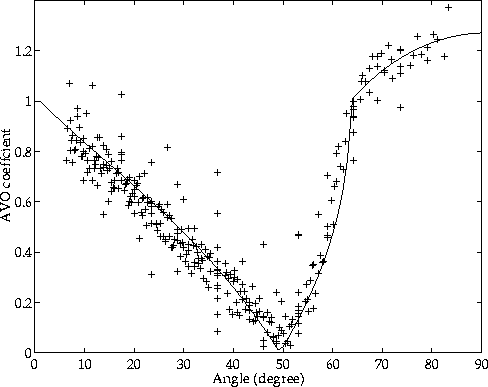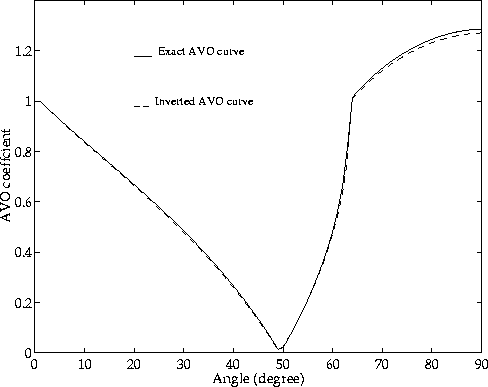In this section we explore the utility of the vertical and radial particle velocity
components measured at the ocean-bottom for the seafloor parameter
inversion. The direct wave components are transformed as before into
the (![]() ) domain and the AVO coefficient is determined.
Inversion of the data yields the following parameters:
) domain and the AVO coefficient is determined.
Inversion of the data yields the following parameters:
vp2 = 1689 m/s and vs2 = 426 m/s.
As with the previous technique, the P-wave velocity is very well determined. The S-wave velocity is within a 3% error bound. The AVO coefficient determined from the data and the AVO curve based on the inverted values are shown in Figure 8. The data fit is very good. The theoretical AVO curve is compared with the inverted one in Figure 9. It is obvious that they are in good agreement.
Using different maximum angles of incidence, we evaluated again how robust the method is for different angular coverages:
|
vzvx
Figure 8 The AVO coefficient calculated from the Vz-Vx data is represented by +. It is overlain by the AVO curve based on the inverted parameters. |  |
|
vzvxavo
Figure 9 Theoretical AVO curve (solid line) versus inverted one (dotted line). |  |
| Angle ( |
vp2 (m/s) | vs2 (m/s) |
| 84 | 1689 - 0.2% | 426 - 2.5% |
| 60 | 1699 + 0.4% | 435 - 0.5% |
| 50 | 1562 - 7.7 % | 328 - 25% |
| 40 | 1665 - 1.7 % | 400 - 8.5% |
It is obvious that for using a maximum angle of 50![]() , the inversion
yields rather badly constrained seafloor parameters. This angle of incidence
corresponds exactly to where the AVO coefficient determined
from the data reaches approximately 0. Otherwise, seafloor parameters
estimated from the two particle velocity components seem to be
constrained in a much better way than the one estimated using pressure
and vertical
particle velocity. This is partly due to the fact that the method inverts only
for two parameters, thus making it more stable, and
that the AVO coefficient is
sensitive to the S-wave velocity over a broader range of angles of incidence.
Furthermore, the two data components used in these methods do not need
to be calibrated prior to the inversion.
, the inversion
yields rather badly constrained seafloor parameters. This angle of incidence
corresponds exactly to where the AVO coefficient determined
from the data reaches approximately 0. Otherwise, seafloor parameters
estimated from the two particle velocity components seem to be
constrained in a much better way than the one estimated using pressure
and vertical
particle velocity. This is partly due to the fact that the method inverts only
for two parameters, thus making it more stable, and
that the AVO coefficient is
sensitive to the S-wave velocity over a broader range of angles of incidence.
Furthermore, the two data components used in these methods do not need
to be calibrated prior to the inversion.